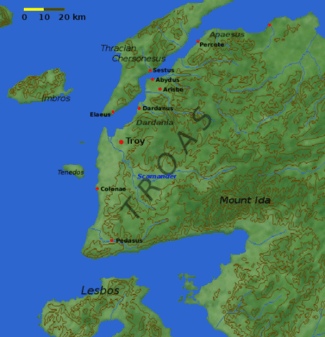Troad
| Troad |
|---|
|
Ancient Region of Anatolia |
|
.jpg)
Part of the walls of Troy |
| Location |
North-western Anatolia |
|---|
| Historical capital |
Troy |
|---|
| Roman province |
Asia |
|---|
 |
The Troad (// or //) or Troas // is the historical name of the Biga peninsula (modern Turkish: Biga Yarımadası, Ancient Greek: Τρῳάς) in the northwestern part of Anatolia, Turkey. This region now is part of the Çanakkale province of Turkey. Bounded by the Dardanelles to the northwest, by the Aegean Sea to the west and separated from the rest of Anatolia by the massif that forms Mount Ida, the Troad is drained by two main rivers, the Scamander (Karamenderes) and the Simois, which join at the area containing the ruins of Troy.
Grenikos, Kebren, Simoeis, Rhesos, Rhodios, Heptaporos and Aisepos were seven rivers of the Troad and the names of the river gods that inhabited each river.
History
The Troad gets its name from the Hittites' name for the region, Taruiša.[1] This identification was first put forth by Emil Forrer, but largely disputed by most Hittite experts until 1983 when Houwink ten Cate showed that two fragments were from the same original cuneiform tablet and in his discussion of the restored letter showed that Taruiša and Wiluša (Troy) were correctly placed in northwestern Anatolia. According to Trevor Bryce, Hittite texts indicate a number of Ahhiyawan raids on Wilusa during the 13th century BC, which may have resulted with the overthrow of king Walmu.
[2] Bryce also reports that archeological surveys conducted by John Bintliff in the 1970s show that a powerful kingdom that held sway over northwestern Anatolia was based at Wilusa (Troy).
Greek settlements flourished in Troas during Archaic and Classical ages, as evidenced by the number of Greek poleis that coined money in their own names. [3] The kings of Pergamum (now Bergama) later ceded the territory of the Troad to the Roman Republic. Under the Empire, the territory of the Troad became part of the province of Asia; under the later Byzantine Empire, it was included in the thema of the Aegean Islands. Following its conquest by the Ottoman Empire, the Troad formed part of the sanjak of Biga.
In the New Testament
Paul visited Troas.[4] He also referred to Troas when he asked his fellow worker Timothy out of Ephesus, to bring the cloak his coat he had left there.[5] This was a journey of about 500 kilometres (310 mi). The change from the story being recounted as "they" to "we" in Acts 20 implies that Paul was joined by Luke when he went through Troas.[6]
See also
Notes
Bibliography
- Trevor R. Bryce. Chapter 14, "The Trojan War: Myth or Reality" in The Kingdom of the Hittites. Oxford: Clarendon Press, 1998. ISBN 0-19-924010-8
|
|---|
| | Main peninsulas | |
|---|
| | Peninsulas in Thrace | |
|---|
| | Peninsulas in Anatolia | |
|---|
| | Related Geographical Features | |
|---|
|
Coordinates: 39°48′N 26°30′E / 39.8°N 26.5°E / 39.8; 26.5

.jpg)